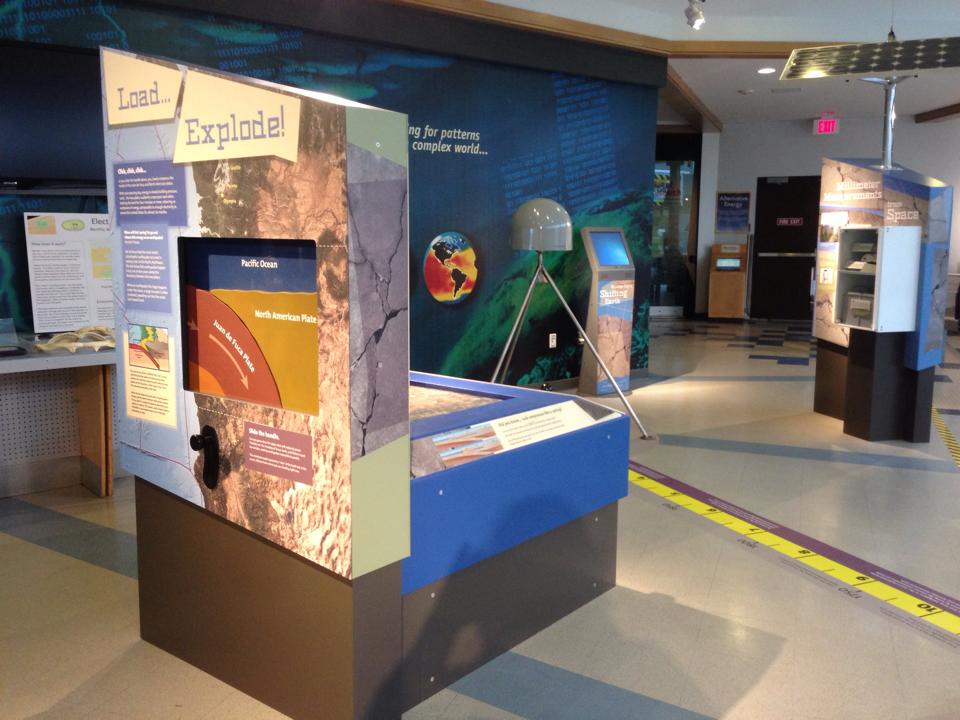June 13, 2014
Go Local or Go Home
Posted by kcompton
By Beth Bartel, Outreach Specialist, UNAVCO
Okay, maybe that title is a bit harsh. When it comes to delivering a message about hazards and risk, there’s certainly benefit in delivering broad messages, to a broad public. But what I’d like to focus on is the power of targeting communication about natural hazards and risk to a local audience, and connecting with your audience through stories.
So let’s start with one. You’re the main character. You’re passing through the town of Newport, Oregon on the beautiful, rugged Pacific Northwestern coast. You stop into Oregon State University’s Hatfield Marine Science Visitor Center, mainly to see their octopus. You walk in, find the beast, and then start to look around the rest of the museum. You see an exhibit about earthquakes and tsunamis and how high-precision GPS is used to measure plate motion, and how it may be used in an earthquake early warning system, and how that system may even come in handy here on the coast. Neat, you think. I’m glad someone is working on that.

This exhibit at the Hatfield Marine Science Visitor Center is a great example of the power of targeting communication about natural hazards and risk to a local audience.
Then you notice what looks like an over-sized ruler on the floor, stretching out about 12 feet from the base of the GPS mock-up. The ruler counts off tens of years, showing how much the ground right here has moved since the last great earthquake. What does this mean? It means that’s how much strain there is on this scrunched-up land, ready to–snap!–release. The last earthquake was 300 hundred years ago, in 1700. The next one is….?
And then, maybe the nearby graphic showing what to do in an earthquake will catch a little more of your attention, and perhaps you’ll spend an extra minute studying the map of the local tsunami evacuation route. As a visitor to the region, you are, after all, one of the most vulnerable publics.
Exploiting this local angle seems obvious enough that on one hand I wonder why to even talk about it, but I think it gets overlooked. Also, it’s expensive, in both time and resources. But if we want results–if we want a resilient public–we have to put in that effort. In another recent post here on The Bridge, John Bwarie addressed the importance of knowing your audience and presenting a local angle when communicating with policy makers. These same principles apply when communicating hazards and risk to the at-risk public.
The museum exhibit at Hatfield is one example of localizing a message. This display is the product of a partnership between UNAVCO, where I work, and Oregon State University, with funds from a National Science Foundation American Recovery and Reinvestment Act (ARRA) grant. The museum hosts an estimated 150,000 visitors per year–in a place highly vulnerable to both earthquakes and tsunamis.
Another example of going local is a program aimed to educate educators, called CEETEP, which gives four-day workshop participants in tsunami- and earthquake-prone communities the tools and confidence to teach the science behind the hazards. Each educator receives a custom tsunami inundation and seismic hazard map designed for easy interpretation, specific to where they teach–whether it is a school, a park visitor center, or an emergency management office.
CEETEP brings together educators from different sectors to collaborate and network, using a principle similar to that described by Jeff Rubin in his recent blog post about the importance of collaboration in designing Oregon’s hazards-related policy. Teachers, park interpretive personnel, and emergency management educators form local teams with the intent of forming lasting relationships. Does it work? The shining example of success from the program is an event run by two park interpreters, a CERT volunteer, and a high school teacher after the workshop. The group ran a program at the Columbia Maritime Museum in Astoria, Oregon featuring teaching activities demonstrated by high school students, a hall of tsunami run-up maps for the entire county at a scale showing individual houses, and a shadow-puppet show depicting a Native American story about the tsunami from the great Cascadia earthquake of 1700.
As for storytelling–a story doesn’t have to be about a real, live character. Give people a tale of what happened, what is happening, and what could happen. Give them a good Earthy character and let them put themselves into the story.
This is the story at Hatfield, for example: Once upon a time, there was an earthquake that relieved the stresses on this fault. But over time, the stresses built up again. They built up so much that the fault wanted to fail again. They built up sooooooo much stress, right here…..
And then, of course, tell them what they can do about it. Drop, cover, and hold is a start. Prepare is even better. Get involved in changing policy? The best we can hope for.
Beth Bartel is an Outreach Specialist at UNAVCO. UNAVCO is a non-profit university-governed consortium that facilitates geoscience research and education using geodesy. Beth’s work has focused on engaging the public in Earth science through social media, hands-on activities, writing, radio, video, public speaking, and photography. She received an MS in geophysics from Indiana University and an MA in journalism and mass communication from the University of Colorado. Beth will be a panelist at the 2014 AGU Science Policy Conference.








